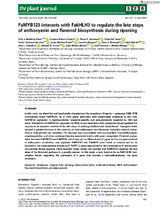Mostrar el registro sencillo del ítem
FaMYB123 interacts with FabHLH3 to regulate the late steps of anthocyanin and flavonol biosynthesis during ripening
| dc.contributor.author | Martínez Rivas, Félix Juan | |
| dc.contributor.author | Blanco Portales, Rosario | |
| dc.contributor.author | Pérez Serratosa, María | |
| dc.contributor.author | Ric-Varas, Pablo | |
| dc.contributor.author | Guerrero-Sánchez, Víctor M. | |
| dc.contributor.author | Medina Puche, Laura | |
| dc.contributor.author | Moyano Cañete, Lourdes | |
| dc.contributor.author | Mercado, José-Ángel | |
| dc.contributor.author | Alseekh, Saleh | |
| dc.contributor.author | Caballero, José Luis | |
| dc.contributor.author | Fernie, Alisdair R. | |
| dc.contributor.author | Muñoz-Blanco, Juan | |
| dc.contributor.author | Molina Hidalgo, Francisco Javier | |
| dc.date.accessioned | 2024-04-17T12:48:40Z | |
| dc.date.available | 2024-04-17T12:48:40Z | |
| dc.date.issued | 2023 | |
| dc.identifier.uri | http://hdl.handle.net/10396/27931 | |
| dc.description.abstract | In this work, we identified and functionally characterized the strawberry (Fragaria × ananassa) R2R3 MYB transcription factor FaMYB123. As in most genes associated with organoleptic properties of ripe fruit, FaMYB123 expression is ripening-related, receptacle-specific, and antagonistically regulated by ABA and auxin. Knockdown of FaMYB123 expression by RNAi in ripe strawberry fruit receptacles downregulated the expression of enzymes involved in the late steps of anthocyanin/flavonoid biosynthesis. Transgenic fruits showed a parallel decrease in the contents of total anthocyanin and flavonoid, especially malonyl derivatives of pelargonidin and cyanidins. The decrease was concomitant with accumulation of proanthocyanin, propelargonidins, and other condensed tannins associated mainly with green receptacles. Potential coregulation between FaMYB123 and FaMYB10, which may act on different sets of genes for the enzymes involved in anthocyanin production, was explored. FaMYB123 and FabHLH3 were found to interact and to be involved in the transcriptional activation of FaMT1, a gene responsible for the malonylation of anthocyanin components during ripening. Taken together, these results demonstrate that FaMYB123 regulates the late steps of the flavonoid pathway in a specific manner. In this study, a new function for an R2R3 MYB transcription factor, regulating the expression of a gene that encodes a malonyltransferase, has been elucidated. | es_ES |
| dc.format.mimetype | application/pdf | es_ES |
| dc.language.iso | eng | es_ES |
| dc.publisher | Wiley | es_ES |
| dc.rights | https://creativecommons.org/licenses/by/4.0/ | es_ES |
| dc.source | Martínez-Rivas, F.J., Blanco-Portales, R., Serratosa, M.P., Ric-Varas, P., Guerrero-Sánchez, V., Medina-Puche, L., Moyano, L., Mercado, J.A., Alseekh, S., Caballero, J.L., Fernie, A.R., Muñoz-Blanco, J. and Molina-Hidalgo, F.J. (2023), FaMYB123 interacts with FabHLH3 to regulate the late steps of anthocyanin and flavonol biosynthesis during ripening. Plant J, 114: 683-698. | es_ES |
| dc.subject | Strawberry | es_ES |
| dc.subject | Fragaria | es_ES |
| dc.subject | Fruit | es_ES |
| dc.subject | Ripening | es_ES |
| dc.subject | Transcription factor | es_ES |
| dc.subject | Malonyltransferase | es_ES |
| dc.subject | MYB | es_ES |
| dc.subject | Anthocyanin/ flavonoid biosynthesis | es_ES |
| dc.subject | Phenylpropanoid | es_ES |
| dc.title | FaMYB123 interacts with FabHLH3 to regulate the late steps of anthocyanin and flavonol biosynthesis during ripening | es_ES |
| dc.type | info:eu-repo/semantics/article | es_ES |
| dc.relation.publisherversion | https://doi.org/10.1111/tpj.16166 | es_ES |
| dc.relation.projectID | Gobierno de España.MINECO/AGL2014-55784-C2-2-R | es_ES |
| dc.relation.projectID | Gobierno de España.MINECO/AGL2017-86531-C2-2-R | es_ES |
| dc.relation.projectID | Gobierno de España.MCIN/AEI/10.13039/501100011033 | es_ES |
| dc.relation.projectID | info:eu-repo/grantAgreement/EC/H2020/SGA-CSA/739582 | es_ES |
| dc.rights.accessRights | info:eu-repo/semantics/openAccess | es_ES |

